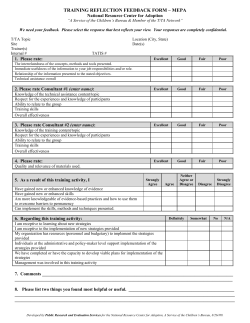
Home | Medicine
June 9, 2013 (final version) Research protocol: A systematic review of the impact of leadership on health information technology adoption in health care providing organisations. Tor Ingebrigtsen1,2,3, Andrew Georgiou1, Antonia Hordern1, Mirela Prgomet1, Yu Jia Julie Li1, Farah Magrabi1, Robyn Clay-Williams1, Johanna Westbrook1, Jeffrey Braithwaite1 1 Australian Institute of Health Innovation, The University of New South Wales, Sydney, Australia 2 Institute of Clinical Medicine, Faculty of Health Sciences, University of Tromsø, Tromsø, Norway 3 CEOs office, University Hospital of North Norway, Tromsø, Norway Address for Correspondence: Prof Tor Ingebrigtsen Centre for Clinical Governance Research Australian Institute of Health Innovation The University of New South Wales Sydney NSW 2052 Australia Ph: 0403737775 Email: tor.ingebrigtsen@unn.no 1 1. Background Health services are increasingly constrained, and leaders are faced with the challenge of building a patient-centred health care system delivering high-quality care in ways that are beneficial both for patients and resource utilization. Successful adoption of health information technology (IT) is considered a prerequisite for such high value health care (Cosgrove DM et al 2013). Accordingly, leaders in health care must lead IT adoption, and training programs for emerging leaders must provide the necessary competencies to do so. Others have reviewed the concept of business management (leadership), as opposed to specialised leadership of IT-support, in IT adoption in general (Bassellier G et al 2001). We are not aware of reviews specifically addressing this topic in the context of healthcare providing organisations, such as hospitals. We therefore suggest that an evidence gap exists with regard to the role of leadership of IT adoption in healthcare. To address this, we aim to conduct a systematic review to identify and synthesise evidence based empirical knowledge on associations between leadership roles and attributes, and outcomes from IT adoption processes in healthcare providing organisations. The research specifically aims to identify a set of competencies, attitudes, subjective norms, perceptions of behavioural control and intentions that leaders in different roles must possess, and behaviours that they must practice, to achieve successful IT adoption. 2. Method 2.1 Protocol and registration The conduct of this systematic review is based on the recommendations in the Preferred Reporting Items for Systematic Reviews and Meta-analyses (PRISMA) statement (Moher D et al 2009). Background information from textbooks on health IT, and IT-leadership in general (Coieira E 2003, Pearlson KE and Saunders CS 2010), confirmed the evidence gap. It also suggested that research in the field of IT-leadership involves the use of varying qualitative, quantitative and mixed methods, and showed that it is carried out and published across a wide range of research traditions (social sciences, business, management and leadership). Accordingly, a systematic review with meta-analysis of quantitative results is not considered feasible. We therefore plan to apply a systematic narrative review method. 2 The protocol is registered in the International Prospective Register of Systematic Reviews (PROSPERO) (PROSPERO website 2013) with the registration number CRD42013004812. 2.2 Eligibility Study eligibility criteria: 1. The study was conducted in an organisation that provide healthcare to patients (e.g. hospitals, primary care organisations) 2. The study reports empirical data on the impact of leadership at an organisational line level on outcomes from health IT adoption Outcomes can be either organisational (e.g. speed or degree of adoption, employee satisfaction, productivity, or other measures of organisational performance) or clinical (e.g. patient outcomes, patient satisfaction). Health IT is understood broadly as any IT system developed and/or implemented to deliver or to support the delivery of healthcare to patients Study methods can be qualitative, quantitative or mixed Exclusion criteria 1. Descriptions of anecdotal personal experiences 2. Studies conducted in organisations related to healthcare, but not providing healthcare to patients, such as National healthcare political governance or legislative bodies Social security providing organisations Medical schools or other health education institutions Infection- or other epidemiological surveillance systems Cancer- or other disease registries Health insurance providers Pharmaceutical companies Veterinary healthcare 3. Studies of generic infrastructure challenges linked to health IT-adoption in developing countries 4. Studies not presenting empirical results on outcomes from IT-adoption, such as 3 Studies proposing theoretical frameworks Studies describing simulations (and not empirical) data Surveys and audits about general attitudes, opinions and perceptions of IT adoption, or use of IT-systems, with no data on outcomes from adoption processes 5. Studies focusing only on Leadership of specialised IT support organisations Leadership in adoption of isolated management systems or technical solutions and standards Informal leadership roles, such as “clinical champions” without analysis of outcomes from interaction with clinical and/or line leaders responsible for providing healthcare 6. Studies of leadership in adoption of specific medical devices (e.g. imaging equipment, surgical equipment, radiation equipment, laboratory equipment, implantable devices etc.) Report eligibility criteria: 1. Articles published between 2000 and the end of May 21. 2013 2. Abstracts available in English 3. Full text available in English, German or Scandinavian languages 2.3 Information sources The following databases will be searched: 1. Medline (via OvidSP) 2. Embase (via OvidSP) 3. Cinahl (via EBSCOhost) 4. Business source premier (via EBSCOhost) The reference list of articles fulfilling eligibility criteria will be checked and additional citations hand-searched with a snowball-approach. 4 2.4 Search To identify articles pertinent to our research objective, we developed a search strategy that combined keywords and subject terms related to our four dimensions of interest: 1. The setting (healthcare providing organisation) 2. The technology in question (health IT) 3. The process of interest (adoption) and 4. The intervention to be studied (leadership). We initially identified relevant keywords via the textbooks that had provided us with background information and prompted us to conduct a systematic review, and from articles identified from the reference lists of the textbooks. Subject terms were then identified through preliminary exploration of the electronic databases. These preliminary searches did not identify all articles providing background information, and we therefore refined our search by exploring and adding new keywords and subject terms until the search identified all possibly eligible articles that we were aware of. Table 1 shows the subject terms and keywords used in the final search, and Figure 1 gives a diagrammatic representation of the search strategy and the study selection process. To maintain a uniform approach, the same search strategy will be applied to both databases searched via OvidSP, and the equivalent terms will be substituted in the search strategy applied via EBSCOhost. 2.5 Study selection All citations obtained through the search will be subject to title and abstract screening by the primary investigator (TI). The full text of titles that appear to possibly meet the eligibility criteria will be comprehensively assessed by TI for eligibility. The selection of studies for inclusion will be validated by another researcher (FM). Discrepancies will be resolved by indepth discussion and subsequent consensus before final decisions on inclusion and exclusion are made. 2.6 Data collection process Included articles will be reviewed in full text by the primary investigator (TI), and other researchers (AH, FM, RC-W) will validate the data extraction. Included studies will be critically appraised for validity and risk of bias, and key results will be recorded to a 5 worksheet. When data in an article appears to be missing or unclear, attempts will be made to contact the authors to acquire additional information or obtain clarification. 2.7 Data items To aid the data collection process, a table has been developed into which data extracted from each study will be documented. The table is intended to be iteratively revised during the data collection process to ensure a convenient categorisation and level of detail in the extracted data. Data items will include: the author, year and country of the study, the aim of the study, the study design, setting and sample, the outcome measures, the key findings, and the authors conclusion. Data on IT knowledge will be categorised as explicit or tacit, and data on leaders attitudes, subjective norms, perceptions of behavioural control and actual proactive IT behaviour and partnership with IT people will be registered. 2.8 Synthesis of results A conceptual framework is considered necessary for analysis of the literature on health IT leadership. In the social sciences, adoption of new technologies, including IT, is generally understood as complex social interventions (Litwin AS 2011). Outcomes are considered results from mutually reinforcing interactions between the (developing) technology, changes in work processes, and organisational changes enabled by the technology. General research on premises for successful IT adoption considers organisational factors, and especially organisational capacity for change (change readiness), as more important than specific characteristics of the technology itself. It is assumed that leaders at all levels in an organisation face a series of strategic choices when new technology is about to be implemented, and that the choices they make strongly influence outcomes from the implementation effort in different organisational units (Avgar AC and Kuruvilla S 2011). Bassellier et al (2001) explored the general concept of the IT competence of business managers, defined as the knowledge that a manager possesses that enables him or her to exhibit IT leadership in his or her area of operations. This knowledge is considered complimentary to, but different from that possessed of specialised IT leaders. The combined competencies of business- and specialised IT-leaders constitute the organisations IT leadership competence. This research understands IT competence as a composite of explicit (technology, applications, systems development, IT management and access to IT knowledge) and tacit (experience from personal use, projects and management, and cognition of process view and vision) IT knowledge. The emerging framework describes a set of specific 6 competencies as prerequisites for effective IT leadership. In addition, it assumes that a set of attitudes, subjective norms and perceptions of behavioural control combined with proactive behavioural intensions and partnership with IT leaders also must be present for actual conduction of effective IT business leadership (Figure 2). Avgar et al (2012) proposed a framework that is specifically developed for analysis of drivers and barriers in health IT adoption, based on the general understanding explained above. The framework is two-dimensional, allowing analysis of organisational factors at three line leadership levels (strategic, operational and frontline), over three different phases of strategic choices (investment, implementation and use) (Figure 3). The authors suggest that this aids analysis and understanding of how competencies, qualifications, capabilities and behaviours of leaders at different organisational levels influence the degree of success during different phases of IT adoption. For our analysis, articles will be explored to identify evidence on how clinical leaders IT competence, attitudes, norms, intensions and behaviours, as defined in the framework developed by Bassellier et al, influence IT adoption in healthcare organisations. The findings will then be organised according to the framework suggested by Avgar et al to understand how different attributes of line leaders at different levels in healthcare organisations influence IT adoption over time. Ethics and dissemination This review does not raise ethical concerns and we do not consider approval from a committee for medical and health research ethics necessary. We plan to publish the review in an international peer-reviewed scientific journal. Funding statement The primary investigator (TI) is supported with a 6 months research sabbatical granted by the Executive board of directors for the University Hospital of North Norway, Tromsø, Norway. 7 References 1. Cosgrove DM, Fisher M, Gabow P, et al. Ten strategies to lower costs, improve quality, and engage patients: The view from leading health system CEOs. Health Affairs 2013; 32: 321-7. 2. Bassellier G, Reich BH, Benbasat I. Information technology: Competence of business managers: A definition and research model. Journal of Management Information Systems 2001; 17: 159-82. 3. Moher D, Liberati A, Tetzlaff J, et al. Preferred reporting items for systematic reviews and meta-analyses: the PRISMA statement. BMJ 2009; 339: 332-9. 4. Coiera E. Guide to health informatics. Hodder Arnold, London, UK, 2003. 5. Pearlson KE, Saunders CS. Managing and using information systems. A strategic approach. John Wiley & Sons Inc, Hoboken NJ, 2010. 6. PROSPERO website. Accessed at http://www.crd.york.ac.uk/NIHR_PROSPERO/ 27.05.2013. 7. Litwin AS. Technological change at work: The impact of employee involvement on the effectiveness of health information technology. Industrial and labor relations review 2011; 64: 863-88. 8. Avgar AC, Kuruvilla S. Dual alignment of industrial relations activity: From strategic choice to mutual gains. Advances in Industrial and Labor Relations 2011; 18: 1-39. 9. Avgar AC, Litwin AS, Pronovost PJ. Drivers and barriers in health IT adoption. Applied Clinical Informatics 2012; 3: 488-500. 8 Table 1. Databases Search Strategy OvidSP Search Strategy: Medline and EMBASE 1 hospital information system/ 2 information system/ 3 information technology/ 4 computer/ 5 medical informatics/ 6 electronic medical record/ 7 computerized provider order entry/ 8 medical order entry systems/ 9 “picture archiving and communication system”/ 10 telehealth/ 11 telemedicine/ 12 decision support systems, clinical/ 13 EMR.ti,ot,sh,ab,kw. 14 information technology.ti,ot,sh,ab,kw. 15 electronic health record$.ti,ot,sh,ab,kw. 16 electronic medical record$.ti,ot,sh,ab,kw. 17 electronic patient record$.ti,ot,sh,ab,kw. 18 radiology system$.ti,ot,sh,ab,kw. 19 PACS.ti,ot,sh,ab,kw. 20 laboratory system$.ti,ot,sh,ab,kw. 21 CPOE.ti,ot,sh,ab,kw. 22 computeri#ed physician order entry.ti,ot,sh,ab,kw. 23 computeri#ed provider order entry.ti,ot,sh,ab,kw. 24 computeri#ed communication system.ti,ot,sh,ab,kw. 25 decision support.ti,ot,sh,ab,kw. 26 DSS.ti,ot,sh,ab,kw. 27 CDSS.ti,ot,sh,ab,kw. 28 information system$.ti,ot,sh,ab,kw. 29 1 OR 2 OR 3 OR 4 OR … 28 EBSCOhost Search Strategy: CINAHL and Business Source Premier S1 (MH “Hospital Information Systems”) S2 (MH “Clinical Information Systems”) S3 (MH “Information Technology”) S4 (MH “Computers and Computerization”) S5 (MH “Medical Informatics”) S6 (MH “Computerized Patient Record”) S7 (MH “Electronic Order Entry”) S8 (MH “Picture Archiving and Communication System”) S9 (MH “Telehealth”) S10 (MH “Telemedicine”) S11 (MH “Decision Support Systems, Clinical”) S12 AB EMR S13 AB information technology S14 AB electronic health record$ S15 AB electronic medical record$ S16 AB electronic patient record$ S17 AB radiology system$ S18 AB PACS S19 AB laboratory system$ S20 AB CPOE S21 AB computeri#ed physician order entry S22 AB computeri#ed provider order entry S23 AB computeri#ed communication system S24 AB decision support S25 AB DSS S26 AB CDSS S27 AB information system$ S28 S1 OR S2 OR S3 OR S4 OR … S27 Setting related subject terms and keywords 30 31 32 33 34 35 36 37 38 39 40 health care/ health facilities/ health care organization/ health service/ health center/ hospital organization/ hospital/ healthcare.ti,ot,sh,ab,kw. medical.ti,ot,sh,ab,kw. hospital.ti,ot,sh,ab,kw. 30 OR 31 OR 32 OR 33 OR … 39 S29 S30 S31 S32 S33 S34 S35 S36 (MH “Health Care Delivery”) (MH “Health Facilities”) (MH “Health Services”) (MH “Hospitals”) AB healthcare AB medical AB hospital S29 OR S30 OR S31 OR … S35 Process related keywords 41 42 43 44 45 46 47 48 49 50 implement.ti,ot,sh,ab,kw. implementation$.ti,ot,sh,ab,kw. implementing.ti,ot,sh,ab,kw. adopt.ti,ot,sh,ab,kw. adoption.ti,ot,sh,ab,kw. uptake.ti,ot,sh,ab,kw. usage.ti,ot,sh,ab,kw. utili#ation.ti,ot,sh,ab,kw. investment.ti,ot,sh,ab,kw. diffusion.ti,ot,sh,ab,kw. S37 S38 S39 S40 S41 S42 S43 S44 S45 S46 AB AB AB AB AB AB AB AB AB AB Technology related subject terms and keywords 9 implement implementation$ implementing adopt adoption uptake usage utili#ation investment diffusion 51 52 53 54 redesign.ti,ot,sh,ab,kw. introduction.ti,ot,sh,ab,kw. introduce.ti,ot,sh,ab,kw. 41 OR 42 OR 43 OR 44 OR … 53 S47 S48 S49 S50 AB redesign AB introduction AB introduce S37 OR S38 OR S39 OR … S49 Intervention related subject terms and keywords 55 56 57 58 59 60 61 62 63 64 65 66 67 68 69 70 71 72 hospital administration/ hospital administrators/ health care management/ leadership/ manager/ leader$.ti,ot,sh,ab,kw. executive$.ti,ot,sh,ab,kw. administrator$.ti,ot,sh,ab,kw. developer$.ti,ot,sh,ab,kw. implementer$.ti,ot,sh,ab,kw. policy maker$.ti,ot,sh,ab,kw. policymaker$.ti,ot,sh,ab,kw. decision maker$.ti,ot,sh,ab,kw. strategist$.ti,ot,sh,ab,kw. manager$.ti,ot,sh,ab,kw. governance.ti,ot,sh,ab,kw. institute.ti,ot,sh,ab,kw. 55 OR 56 OR 57 OR 58 OR … 71 S51 S52 S53 S54 S55 S56 S57 S58 S59 S60 S61 S62 S63 S64 S65 S66 S67 (MH “Health Facility Administration”) (MH “Health Facility Administrators”) (MH “Leadership”) (MH “Management”) AB leader$ AB executive$ AB administrator$ AB developer$ AB implementer$ AB policy maker$ AB policymaker$ AB decision maker$ AB strategist$ AB manager$ AB governance AB institute S51 OR S52 OR S53 OR … S66 Search limiters 73 29 AND 40 AND 54 AND 72 74 limit 73 to ((“English or German or Norwegian”) and yr=“2000-Current”) S68 S28 AND S36 AND S50 AND S67 S69 Limiters – Date Published from: 20000101-20131231; Language: English, German, Norwegian In OvidSP - ti,ot,sh,ab,kw = title, original title, subject heading, abstract, keyword heading In EBSCOhost - AB = abstract Search was conducted on May 21st 2013 in all databases. 10 Figure 1. Diagrammatic representation of the search strategy 11 Figure 2. Framework for classification and analysis of IT-competencies (Bassellier G et al 2001) 12 Figure 3. Framework for analysis of IT adoption (Avgar AC et al 2012) 13
© Copyright 2025









